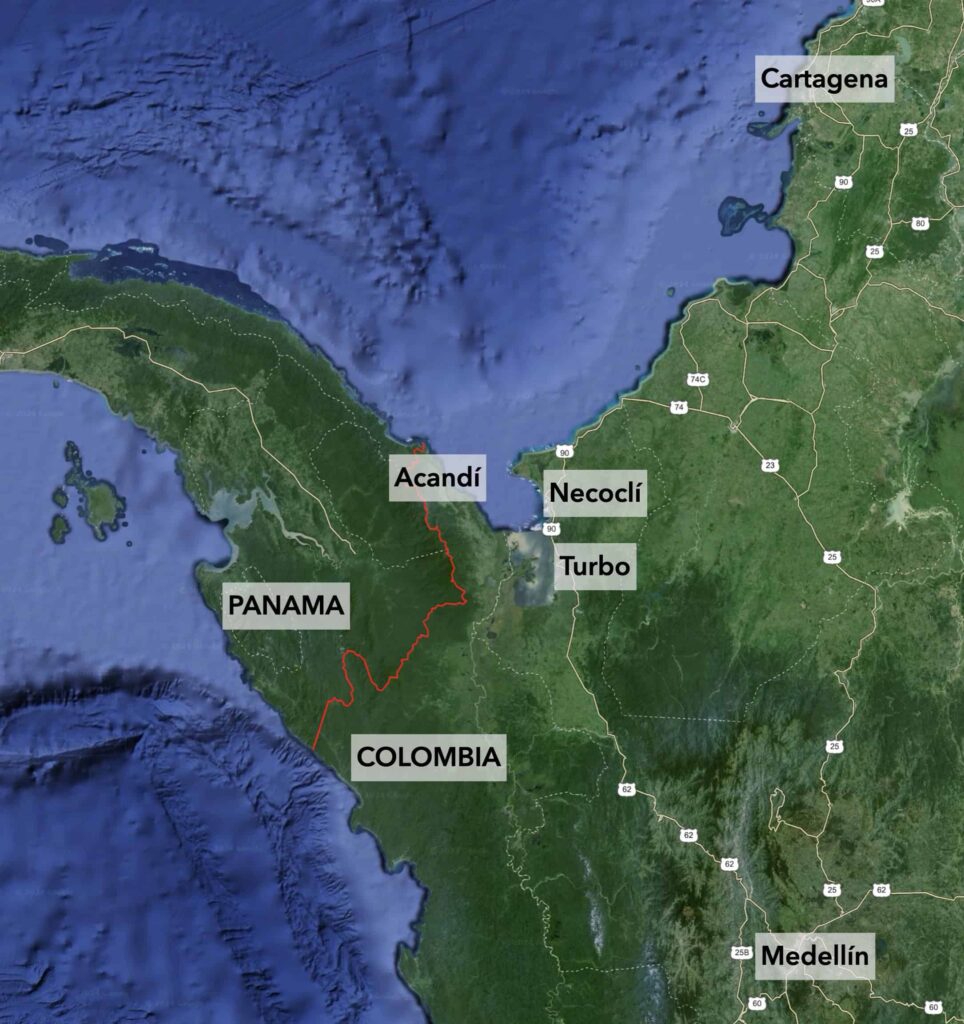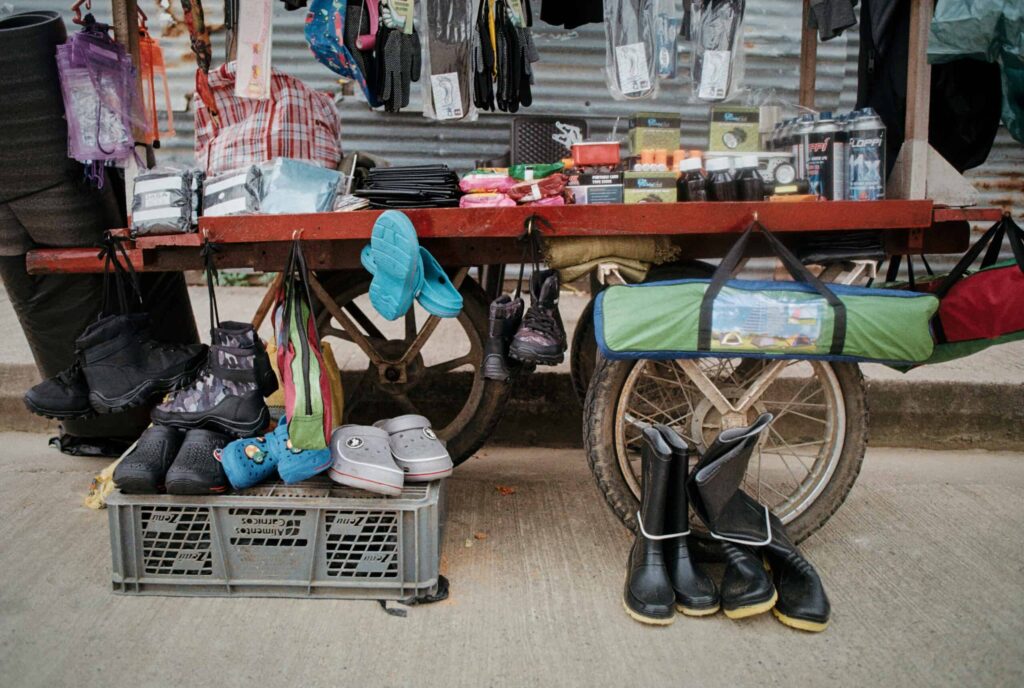
Text: Josefina Salomón / Photos: Sergio Ortiz Borbolla
A simple bar chart shows part of the immensity of the crisis. While a decade ago, between 1,000 and 2,000 people managed to cross what was considered the impenetrable Darien jungle separating Colombia and Panama every year, the figure now is closer to 1,000 a day.
A combination of new visa requirements and worsening humanitarian situations has pushed increasing numbers of people to make the dangerous journey as crime organizations that control the areas profit from them.
Adam Isacson, Director of the Defence Oversight programme at the Washington Office on Latin America, recently spent time in the town of Necoclí, on the shore of Colombia’s Golf of Urabá. He spoke with In.Visibles about the impact of the control the Golf Clan has on the area, and the least bad solutions to the growing challenges.
Josefina Salomón (JS): You have been documenting migration dynamics for decades. What has changed in the Darien Gap over recent years?
Adam Isacson (AI): Ten years ago, the Darian Gap was considered impenetrable. Back then you would see 1,000, maybe 2,000 intrepid people trying to cross every year. Things started to change between 2014 and 2016 when Haitians who had left Haiti after the 2010 earthquake and were living in Brazil and Chile found those countries to be very inhospitable and decided to make this incredible journey overland all the way to the United States. But in those years, we’re talking 30,000 people a year, at the most.
And then there was the pandemic.
In 2021, once travel restrictions started to head up, suddenly 130,000 people went through the Darien Gap — about 100,000 of them were Haitians. Then, in the beginning of 2022, Mexico began requiring visas to Venezuelans, which made it impossible for them to arrive easily to Mexico by air. So, within a few years you saw this huge spike in Venezuelans traveling through the Darien Gap. Since 2022, nearly 600,000 Venezuelans have made this trip. Mexico is requiring visas for Peruvians as well so that number is likely to increase. There are also many people from outside the Americas, including China, Afghanistan and Nepal making the journey. In fact, Panama registers around 100 nationalities crossing the country every year.

JS: You recently spent time in Necoclí, where many migrants start their journey. What did you see there?
AI: When I was there, I asked myself why people were taking boats across the Gulf of Urabá instead of taking the land route to get to Panama more directly. The reason is because the whole area is controlled by the Gulf Clan, one of the most powerful crime organizations in Colombia. They decided that they don’t want people migrating through the other side, closer to the Panama border because that’s where a lot of their cocaine trafficking boats leave, and they don’t want anybody interfering or drawing government presence. That also gives them a better ability to monitor everybody who’s leaving and making sure they’re collecting money from every single migrant who passes through.
The control they have is very noticeable. People from international organizations or local officials tell you not to take pictures, they lower down their voices when the talk about the group, they don’t want to be overheard.

JS: They don’t even allow migrant shelters in the town
AI: Yes. All they want is migrants to pay. There’re only two places along the entire US-bound migration route that I’ve heard of where there’s no charity-run shelters. One is Necoclí and the other one is Nuevo Laredo, in Mexico, where the Northeast Cartel has said that no one can operate a shelter unless they pay them a fee for every migrant who’s stays there. So, most of the shelters have shut down. That’s how bad it is.
JS: The fact that migrants are still going to Necoclí seems to show their level of desperation…
AI: It absolutely does. And what I just described is probably a walk in the park compared to living for a week in the slums of Caracas. But I should say there’s a flip side of that where if you can afford to pay the group, and the group wants maybe $100 to $200 per person, if you can pay, you will be protected. If anybody harms you at all, if they touch a hair on your head and do you harm and you are a paying customer, whoever assaulted you on the Colombian side will be killed. Because they have this monopoly of violence in that part of the country, they can enforce it. This is why most of the assaults, robberies, rapes and murders of migrants happen on the Panamanian side after the Gulf Clan control dissipates.
JS: What is Colombia doing to protect these people?
AI: Not very much. Historically, Colombia has left many parts of its territory ungoverned. It is one of the reasons why it’s the number one coca-growing country, why armed groups thrive so much and why the area around Necoclí has been dominated by paramilitaries since they viciously kicked the guerrillas out in the late ’90s and early 2000s. When you look at violence statistics, this banana producing region is relatively peaceful because the Gulf Clan has a monopoly on criminality.
In parallel, Colombia’s state presence in many areas, and the presence of the security forces has shrunk. That is because of a lack of money but also due to managerial problems in the Petro government and lack of political will in the Duque government.
JS: One of the things that you say in the report is that Necoclí is a perfect example of how not to manage a migration crisis. What would be a good way to do it?
AI: There isn’t a good answer to this. There’s two main constraints here. One is the impossibility of blocking migrants. These are desperate people who are going to come and there’s very little anybody can do to make their suffering worse than what they’re living through right now. The other constraint is that if you do not at least make some display of trying to controll the flow, then Washington and others will just fall right on top of you for not doing enough.
Somewhere in between would be some humanitarian corridor that has protection for the people coming through but somehow manages with more territorial control to at least meter the flow somewhat. You just can’t have organized crime decide how many people come every day. That would be much better than what we have now, but it would still be very hard and very expensive to set up. We’re really looking at the least bad options here, especially while the United States can’t make even the most minor changes to its immigration laws.

JS: None of the current strategies seem to account for the best interests of people seeking to leave a desperate situations…
AI: Right. The best interests of these families and children in particular, don’t really come up much in this discussion right now. There are countries along the route, like Honduras, Costa Rica, Panama, where their whole goal is to register people and then get them on buses and moving them along. That’s a little better because it cuts organized crime out of the picture.
The United States hates that, of course. Some version of that might be more palatable to some in the United States if it did come with some control of the daily number, which would always be too high for the United States, but it might be more palatable for if it came with a much greater effort to integrate migrants who might be happy to live in say Mexico, which simply is not absorbing enough migration for a country of 130 million people.
JS: Tackling organized crime seems to be a big part of the challenge facing governments, although it is an enormous one…
AI: Yes. I think they must start by combating organized crime-tied corruption in the state. Make examples of officials, especially officials who are keynotes on the network, who are, probably for personal gain, failing to confront these organized crime groups who are not just the soldier or the policeman who is waving people through the checkpoints or allowing the Gulf Clan to operate out in the open, but their bosses and others. Organized crime, unlike an insurgency which wants to fight a government, needs a government to do what it does so you need to break those links. That’s where I would start.

JS: It feels as if Colombia has been trying to do this for decades. But what you’re saying is that they’ve been doing it wrong, and that’s why it hasn’t worked.
AI: They managed to weaken the FARC (Revolutionary Armed Forces of Colombia) to the point where they were willing to negotiate. But insurgencies are so much easier to fight than organized crime because they want to fight you. Organized crime groups don’t really want to attack you, they prefer to undermine you from within, destroy trust within your institution and make it weaker. That makes it so much harder to fight them.
And so, your main weapon for fighting organized crime is witnesses, investigators, prosecutors, and judges. This is not something Colombia has figured out how to do. They still act as though they’re fighting an enemy that is living in remote jungle encampments when in fact, their enemy, the one who is really undermining the state, is probably living in a condo in Medellín half their time.
JS: One of the debates that has generated a lot of attention is the one about drug decriminalization as a way to tackle organized crime but would it work considering these groups manage large portfolios?
AI: If you go back to the 1920s in the United States, we got rid of prohibition of alcohol and crime went way down. We’re seeing the same with cannabis – and all of that income stream that the Mexican groups in particular were getting from cannabis has been almost completely taken away.
That shows that, yes, by legalizing or regulating a drug, you can take away a huge income stream from these groups. But we also need to talk about some of the harms that you must be prepared to deal with if drug use increases so you need a state to deal with that. It’s not a panacea, but it would certainly deal a huge blow to organized crime if you were to make these substances more legal and more regulated.
However, even if you did that, you would not be really solving much because even though drugs are probably the number one income stream for organized crime, the groups can just increase the list of precious metals they illegally mine, they can traffic and smuggle more people, they can do more counterfeiting, they can harvest more timber from the rainforest. You still have those basic problems of state absence and impunity for organized crime-tied corruption that will allow them to expand into these other businesses and continue to grow.
This interview was edited for length and clarity.